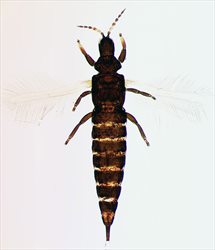
Female
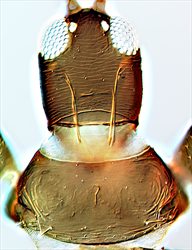
Head & pronotum (female)

Antenna
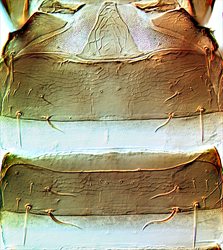
Pelta & tergites II-III
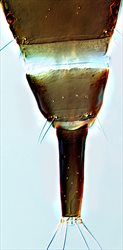
Female tergites VIII-X
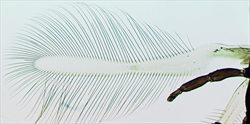
Fore wing
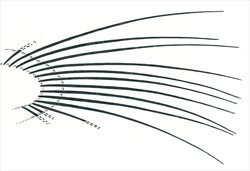
Fore wing apical cilia smooth
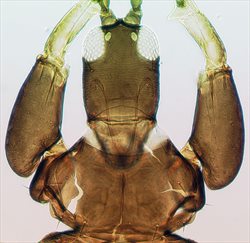
Head & pronotum (large male)
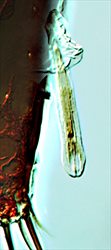
Male aedeagus

Male aedeagus

Tubes of male & female
Both sexes fully winged. Body brown to dark brown, fore tarsi and base of antennal segment III yellow; fore wing pale with base extensively shaded. Antennae 8-segmented, segment III with 2 sense cones, IV with 4 sense cones; VIII short and broad at base. Head slightly longer than wide; maxillary stylets one third of head width apart, retracted to postocular setae, maxillary bridge complete; postocular setae acute and short, usually not reaching posterior margin of compound eyes. Pronotal anteromarginal and midlateral setae acute, no longer than discal setae; epimeral sutures complete; prosternal basantra and ferna present, mesopresternum eroded to paired lateral triangles. Fore tarsal tooth minute in female. Fore wing constricted medially, with 7–12 duplicated cilia, sub-basal setae acute or blunt. Tergite IX setae S1 bluntly pointed, much shorter than tube, S2 acute.
Male with no pore plate on sternite VIII; fore femora size is subject to allometric variation, and large males have the fore tarsal tooth large; tergite IX setae S2 short and stout; pseudovirga of aedeagus slender.
The genus Haplothrips is one of the three most species-rich genera of Thysanoptera, and currently includes about 245 species worldwide. Most of these species come from the Holarctic or the Old World tropics, with 80 listed from Europe and 14 from Britain. No Haplothrips species is known to be endemic to the Neotropics, although a few are native to southern South America (Mound & Zapater, 2003). Haplothrips species are largely phytophagous, particularly associated with the flowers of Asteraceae and Poaceae, but some are predatory (Mound & Minaei, 2007). Among species of this genus Haplothrips leucanthemi is unusual because of the short setae on the head and pronotum, although this character state is shared with propinquus. However, the identity of H. leucanthemi is a contentious problem. Both sexes can be found living in large daisy flowers, such as those of Chrysanthemum leucanthemum. In contrast, only females are ever found living in red clover flowers, Trifolium pratense, and these females are often known as H. niger. Currently, this is considered to be a parthenogenetic strain of H. leucanthemi (Mound & Minaei, 2007; Minaei & Mound, 2008).
Bisexual populations breed particularly in the flowers of Chrysanthemum leucanthemum, but also on some other Asteraceae, and large and small males can occur together. Unisexual populations occur on Trifolium pratense [Fabaceae].
Taken widely in England & Scotland, from the south coast to northern Scotland (Mound et al., 1976), and widespread across the Holarctic south to Iran and California (Hoddle et al., 2004). Also introduced to Hawaii, Australia and New Zealand (Mound & Walker, 1986: as H. niger).
PHLAEOTHRIPIDAE - PHLAEOTHRIPINAE
Haplothrips leucanthemi (Schrank)
Thrips leucanthemi Schrank, 1781: 298
Phloeothrips niger Osborn, 1883: 154
Phloeothrips armatus Lindeman, 1887: 335
Phloeothrips obscuricornis Reuter, 1909: 20
Haplothrips trifolii Priesner, 1919: 130
Zygothrips wyomingensis Watson, 1923: 82
Haplothrips scythicus Knechtel, 1961: 1325
Hoddle MS, Mound LA & Nakahara S (2004) Thysanoptera recorded from California, U.S.A.: a checklist. Florida Entomologist 87: 317–323.
Minaei K & Mound LA (2008) The Thysanoptera Haplothripini (Phlaeothripidae) of Iran. Journal of Natural History 42: 2617–2658.
Mound LA & Minaei K (2007) Australian insects of the Haplothrips lineage (Thysanoptera – Phlaeothripinae). Journal of Natural History 41: 2919–2978.
Mound LA, Morison GD, Pitkin BR & Palmer JM (1976) Thysanoptera. Handbooks for the Identification of British Insects 1 (11): 1–79.
Mound LA & Walker AK (1986) Tubulifera (Insecta: Thysanoptera). Fauna of New Zealand 10: 1–140.
Mound LA & Zapater MC (2003) South American Haplothrips species (Thysanoptera, Phlaeothripidae), with a new species of biological control interest to Australia against weedy Heliotropium amplexicaule (Boraginaceae). Neotropical Entomology 32: 437–442.